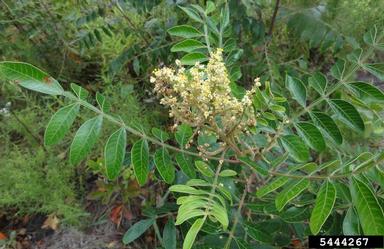Winged Sumac
Rhus copallinum
Family: Anacardiaceae
Natural History

Leaves and inflorescence of winged sumac
Photo credit: Karan A. Rawlins, University of Georgia, Bugwood.org
The winged sumac is a deciduous woody shrub that commonly grows up to 10 feet tall, although 18 feet in height have been recorded. The leaves are compound and have leafy wings along the rachis (leaf stem). Winged sumac is dioecious which means there are male and female plants. The female plants produce greenish-yellow flowers that appear in summer and are clustered together. The red fruits mature in the fall and are eaten by many species of wildlife.
The winged sumac can be found growing in a variety of habitats but are most commonly found in upland habitats and areas with a lot of disturbance such as old fields, roadsides, and fence rows. Its current range includes the eastern United States and parts of eastern Canada.
The fruit of the winged sumac provides food for wildlife during the winter. Many different birds including songbirds, quail, and wild turkey as well as several species of mammals eat the fruit. The bark is eaten by fox squirrels and rabbits and the fruit and stems are eaten by white-tailed deer.
The winged sumac is desirable as an ornamental plant because the leaves turn red in the fall which adds color to landscapes.
